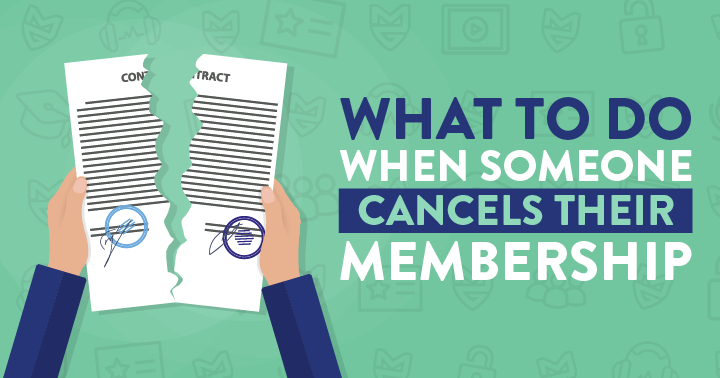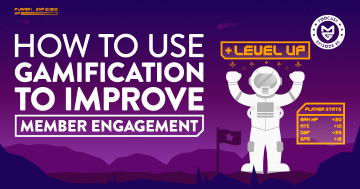Like it or not, member cancellations are going to happen.
Hopefully, if you run your membership site well, those cancellations will come at the end of a long tenure; regardless, they will happen.
How you deal with these cancellations has numerous implications for the continued success of your membership site or online course; so it’s important to know how to handle them.
What you should do about member cancellations
As hard as it may be, especially in the earlier days of your membership, you need to try not to take cancellations personally. It's easy to interpret them as meaning your product isn’t up to scratch, or your customers are unhappy.

Don't let this be you when a member cancels
Members will leave your site for a variety of reasons. It’s important to handle the whole process in a manner that doesn’t leave a bad taste in their mouths.
Make an attempt to change their mind
Even if your member is set on leaving your membership, they could actually take a great deal of offence if you don’t at least make a cursory attempt to keep them onboard!
Assuming your website has a page for cancellation – whether it’s one where someone can actually cancel themselves, or simply a page with information on who to contact for manual cancellation – then this is the prime spot for making a final ‘appeal’ for your departing member to stick around.
For a personal touch, you could try adding a video. Make it one that you update regularly, outlining the exciting stuff you have planned in the future that you’d hate for them to miss out on.
You might even ask someone who is planning on leaving to email you or your support team. This gives you an opportunity to address any issues before they make the final decision to go.
You may want to offer an alternative payment plan, the option to pause their membership, or some form of “down-sell” to a lower tier, or a scaled back version of your membership product.
You’re not going to change everyone’s mind, but even if you salvage just 10% of potential cancellations, the minimal effort it takes to at least try is going to be worth it.
Survey your lapsed members
38% of membership owners do not collect feedback from members who leave.
This is a huge missed opportunity!
Feedback on the reasons people leave your membership is extremely valuable! It will highlight any gaps in your strategy or weaknesses in your product, so it makes sense to survey those members who have left, or are on their way out the door.
Keep your survey brief – you could even limit it to a single question of “Please let us know why you’re leaving” and let people type whatever they want.
It’s easy to set up a basic survey using tools like Gravity Forms or Survey Monkey; you could place this either on the pre-cancellation page, post-cancellation page, or even email it out to lapsed members a couple of weeks after they’ve gone.
The responses you get should give you some action points to work on. If you want to get more honest feedback, you might want to consider making the survey anonymous. Alternatively, if you get people to fill in their email address when completing the survey, it could give you the opportunity to try to address that person's problems.
Try to win your members back further down the road
At Membership Academy, over 25% of people who cancel their membership ultimately return to us within a year, because we have a “win back” strategy in place. And we see similar results with other membership sites who are actively following up with lapsed members to entice them to return.
And yet, almost two-thirds of memberships do not have a strategy for winning back ex-members.
Circumstances change. Over time, people who have left your membership may find themselves missing being a part of your community, or in a better position to rejoin, so it’s always worth making an attempt to win back members who have left later on down the road.
If your email marketing provider has automation features, you could set it so that anyone cancelling or letting their membership expire gets put onto a special “lapsed members” list.
The purpose of this would not be to enable you to relentlessly spam them. Instead, this gives you a means of running a very brief “win back” sequence weeks or months down the line.
You have to tread carefully here; coming on too strong and blasting out endless emails will not go down well.
Perhaps simply send a “We miss you” email. Maybe with a special returning members offer. A single email follow up gives you an opportunity to make a last attempt to win your member back, without irritating them by hammering their inbox.
Another possible use of this list is for remarketing Facebook ads – whereby you upload your list of lapsed members as a custom ad audience, then run ads to just those people on Facebook.
If you’ve not yet tapped into remarketing, it’s an extremely powerful paid advertising option, and this is just one potential use of it.
What you really shouldn't do about member cancellations
If you had things your way, your members would never leave – however, some people take this sentiment a little too far to the point of attempting to stop people leaving completely.
The logic behind this is flawed.
You cannot force someone to want to remain a part of your membership site, and even if you could, why would you want to keep someone around who absolutely does not want to be there?
Making it difficult to cancel your membership
One of the big faux pas people make in trying to keep cancellations down is making it as complicated and as difficult as possible for someone to cancel their account.
People will remove any functionality that lets people do it themselves, make it hard to find a point of contact, and give members the runaround when they do eventually find someone to call or email.
There’s so little point in adopting this approach, where you’re essentially hoping that you can frustrate someone into submission, and then maybe they’ll forget that they were going to cancel.
You need to make the decision to cancel difficult, but the process easy.
Considering the most popular payment processors used by membership site owners – such as Paypal and Stripe – have the facility for the customer to cancel their subscription payments at their end, if someone has no luck cancelling through your site, they’re going to find another way out.
In this case, it’s far better to not stand in the way, and instead to capitalise on the opportunity to try to change their mind or identify the reason they want to leave and leverage this to improve your product or processes.
Enforcing cancellation periods
Another tactic people use is to insist on a cancellation period, during which time the outgoing member is presumably expected to continue payment.
Unless your member signs a legally binding contract, there’s little you can do to enforce this – and even if they do agree to the terms, chances are there’s still little you can do, unless you plan on going to court for the sake of a few dollars!
Once again, it’s likely that if you try to stall the member from leaving and try to continue taking money from them, they’ll simply cancel their subscription with their payment provider, or block payment with their bank or card company.
You’ll be left in the same position as if you’d just let them go, only with a now very annoyed ex-customer, who will almost certainly tell others to avoid you like the plague.
Nobody likes to see their members leave; especially when we work so hard to get them in the first place.
But when they do, it’s far better to handle it in a dignified, positive manner and attempt to get something good out of the situation, rather than throwing a fit and burning your bridges with them on their way out.
What are your strategies for managing membership cancellations? Let us know!





